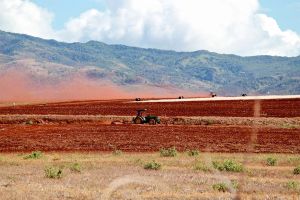Syngenta
Ka Pae Aina
According to Syngenta's website they "... invest and innovate to transform the way crops are grown and protected to bring about positive, lasting change in agriculture. We help farmers manage a complex set of challenges from nature and society. Our approach is to ensure that everybody wins: that farmers are prosperous, agriculture becomes more sustainable, and consumers have safe, healthy and nutritious food."[1]
Syngenta's method of achieving these, seemingly, noble goals is by wantonly spraying toxic pesticides and insecticides over crops to test their resistance to the chemicals and as a result the Ka Pae Aina's Native residents have been poisoned enmasse by these loosely regulated experiments. Residents have described the test sites as releasing large red dust clouds into the air covering their houses and cars with a thin layer of red- especially during periods of high winds. Because the island is able to grow food year round these types of experiments, involving mass chemical spraying of crops, also occur year round.[2] The mass testing of toxic chemicals has caused residents to dub Waimea, located on the island of Kauai, where much of Syngenta's spraying took place, "Poison Valley." [3]
2016 Lawsuit
In 2016 Syngenta sprayed a pesticide on one of its farms in Kekaha, Kauai, containing chlorpyrifos, over genetically modified corn crops. According to EPA regulations after spraying chlorpyrifos it is required to wait 24 hours before sending workers into the field or require workers to wear protective gear, but Syngenta did neither sending 19 workers into the contaminated fields. Syngenta allegedly did not realize what had happened and after realizing isolated and decontaminated 35 workers- the EPA deemed the decontamination efforts were insufficient. 10 of the workers were eventually sent to the hospital, due to chemical exposure, with three staying over night, which the EPA also deemed to be insufficient due to Syngenta's lack of urgency [4] [5]
In 2017 another incident occurred when Syngenta sprayed the same chemical over fields and did not properly post warning signs indicating there was poison covering the crops. Five crews containing 42 employees were potentially exposed to the toxic chemical and at least one worker displayed symptoms of pesticide poisoning. After the incidents the EPA filed a lawsuit against Syngenta on behalf of the affected workers. "The result of oversights allegedly affecting as many as 77 workers — involving multiple failures to warn, properly post signs and the like — led to a 388-count complaint. With maximum penalties as high as $19,000 per violation, Syngenta faced potentially millions of dollars in fines."[6]
Instead of the proposed 4.8 million dollars the EPA was seeking in damages, based on the 2016 incident alone, Syngenta and the EPA reached a settlement agreement of 400 thousand dollars to pay for 11 worker protection training sessions for growers and an additional 150 thousand dollar civil penalty. The agreement was about 3 percent of what the EPA originally announced it was seeking.[7]
In response, Alexis Strauss, a regional administrator of the EPA, stated: “You don’t get to settle with a company by getting the maximum amount for every violation.”[8]
Viptera Corn settlement
In 2020, Syngenta agreed to pay out a $1.5 billion settlement in a class action lawsuit related to its marketing of Viptera and Duracade-traited corn seed, after corn market prices declined following China's rejection of certain corn shipments in 2013 as a result of the unapproved genetically engineered traits. AgWeb reports this to be the largest U.S. ag settlement in history.[9]
Sources
- ↑ https://www.syngenta.com/en/company/our-purpose-and-contribution
- ↑ https://beyondpesticides.org/dailynewsblog/2014/05/report-finds-pesticide-residues-in-hawaiis-waterways/
- ↑ https://grist.org/business-technology/gmo-companies-are-dousing-hawaiian-island-with-toxic-pesticides/
- ↑ https://www.epa.gov/sites/default/files/2018-02/documents/fifra-09-2017-0001-syngenta_seeds_llc_amended_complaint-2018-01-12.pdf
- ↑ https://www.epa.gov/archive/epa/newsreleases/epa-reaches-agreement-syngenta-farmworker-safety-violations-kauai.html
- ↑ https://www.civilbeat.org/2018/02/epa-settles-syngenta-pesticide-claim-for-pennies-on-the-dollar/
- ↑ https://www.epa.gov/archive/epa/newsreleases/epa-reaches-agreement-syngenta-farmworker-safety-violations-kauai.html
- ↑ https://www.civilbeat.org/2018/02/epa-settles-syngenta-pesticide-claim-for-pennies-on-the-dollar/
- ↑ https://web.archive.org/web/20200902000748/https://www.agweb.com/article/first-syngenta-mir162-payments-be-mailed
